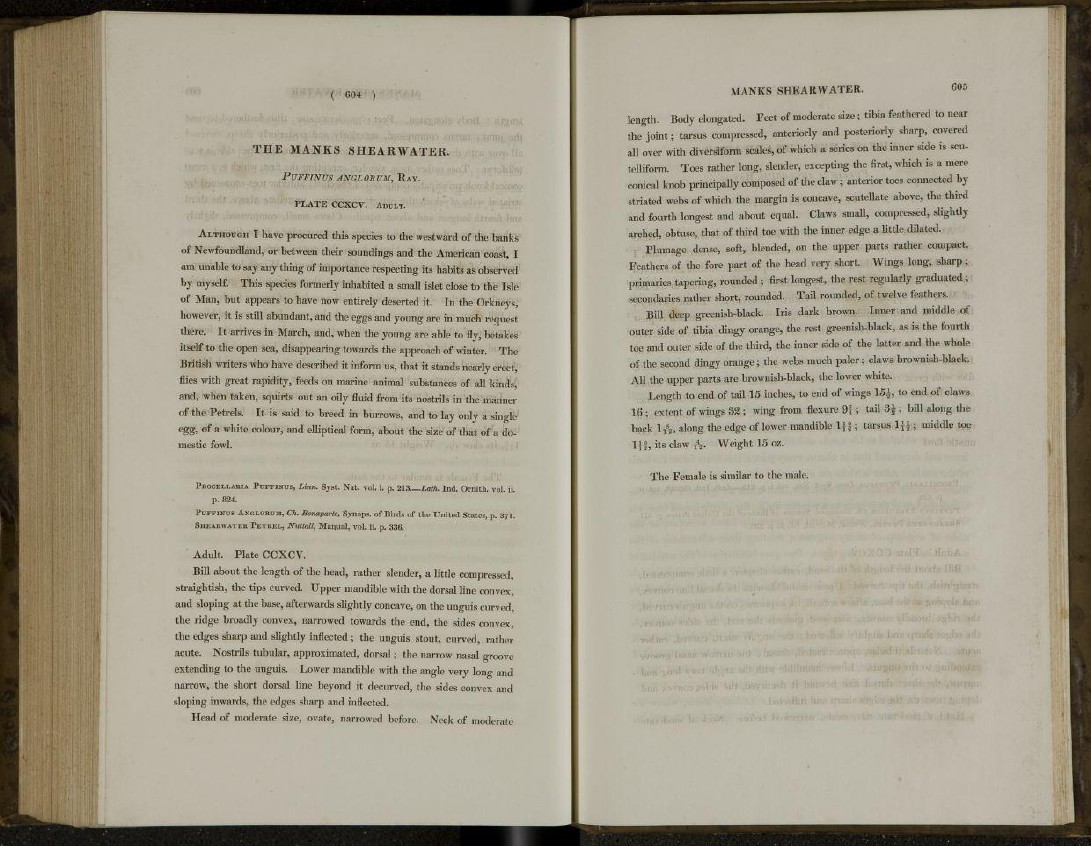
( 604 )
T H E MANKS SHEARWATER.
PlTFFINUS ANGLORUM, RAY.
P L A T E C C X C V . ADULT.
ALTHOUGH I have procured this species to the westward of the banks
of Newfoundland, or between their soundings and the American coast, I
am unable to say any thing of importance respecting its habits as observed
by myself. This species formerly inhabited a small islet close to the Isle
of Man, but appears to have now entirely deserted it. In the Orkneys,
however, it is still abundant, and the eggs and young are in much request
there. It arrives in March, and, when the young are able to fly, betakes
itself to the open sea, disappearing towards the approach of winter. The
British writers who have described it inform us, that it stands nearly erect,
flies with great rapidity, feeds on marine animal substances of all kinds,
and, when taken, squirts out an oily fluid from its nostrils in the manner
of the Petrels. It is said to breed in burrows, and to lay only a single
egg, of a white colour, and elliptical form, about the size of that of a domestic
fowl.
PROCELLARIA PUFFINUS, Linn. Syst. Nat. vol. i. p. 213.—Lath, Ind. Ornith. vol. ii.
p. 8 2 4 .
PUFFINUS ANGLORUM, Ch. Bonaparte, Synops. of Birds of the United States, p. 371.
SHEARWATER PETREL, Nuttall, Manual, vol. ii. p. 3 3 6 .
Adult. Plate CCXCV.
Bill about the length of the head, rather slender, a little compressed,
straightish, the tips curved. Upper mandible with the dorsal line convex,
and sloping at the base, afterwards slightly concave, on the unguis curved,
the ridge broadly convex, narrowed towards the end, the sides convex,
the edges sharp and slightly inflected; the unguis stout, curved, rather
acute. Nostrils tubular, approximated, dorsal; the narrow nasal groove
extending to the unguis. Lower mandible with the angle very long and
narrow, the short dorsal line beyond it decurved, the sides convex and
sloping inwards, the edges sharp and inflected.
Head of moderate size, ovate, narrowed before. Neck of moderate
MANKS SHEARWATER. 605
length. Body elongated. Feet of moderate size; tibia feathered to near
the joint; tarsus compressed, anteriorly and posteriorly sharp, covered
all over with diversiform scales, of which a series on the inner side is scutelliform.
Toes rather long, slender, excepting the first, which is a mere
corneal knob principally composed of the claw; anterior toes connected by
striated webs of which the margin is concave, scutellate above, the third
and fourth longest and about equal. Claws small, compressed, slightly
arched, obtuse, that of third toe with the inner edge a little dilated.
Plumage dense, soft, blended, on the upper parts rather compact.
Feathers of the fore part of the head very short. Wings long, sharp;
primaries tapering, rounded ; first longest, the rest regularly graduated;
secondaries rather short, rounded. Tail rounded, of twelve feathers.
Bill deep greenish-black. Iris dark brown. Inner and middle of
outer side of tibia dingy orange, the rest greenish-black, as is the fourth
toe and outer side of the third, the inner side of the latter and the whole
of the second dingy orange; the webs much paler; claws brownish-black.
All the upper parts are brownish-black, the lower white.
Length to end of tail 15 inches, to end of wings 15^, to end of claws
1(); extent of wings 32 ; wing from flexure 9] ; tail 3^ ; bill along the
back l / g , along the edge of lower mandible tarsus 1 \\ ; middle toe
11 its claw j%. Weight 15 oz.
The Female is similar to the male.